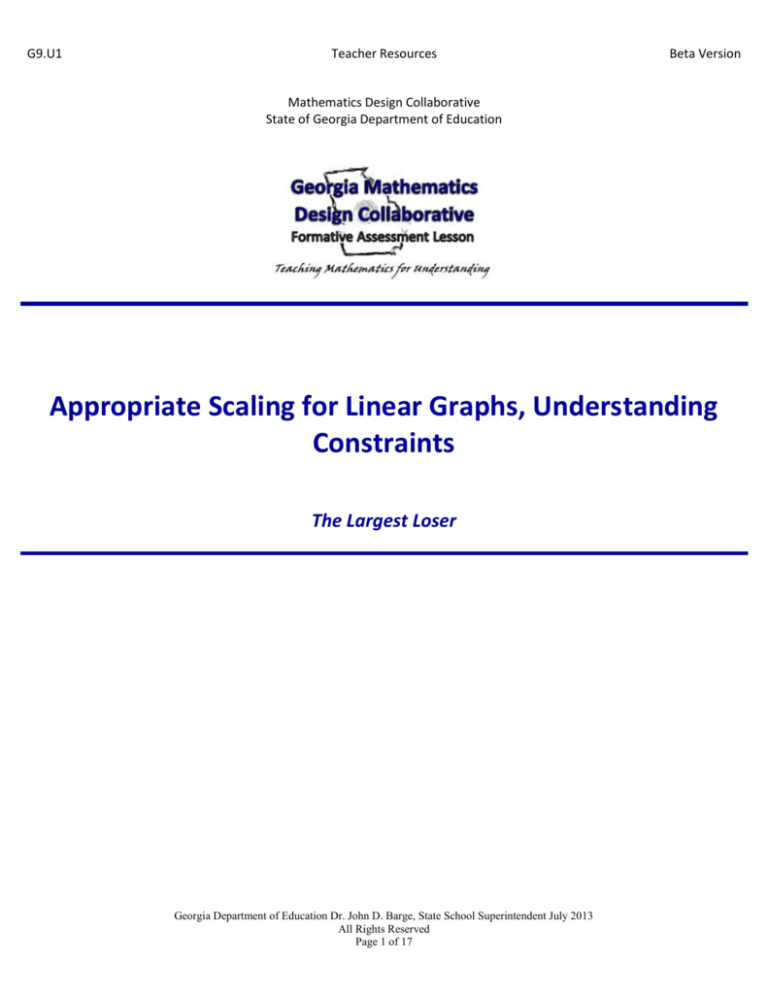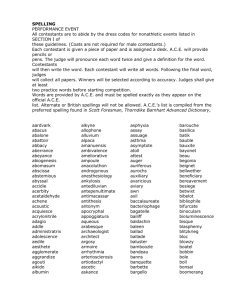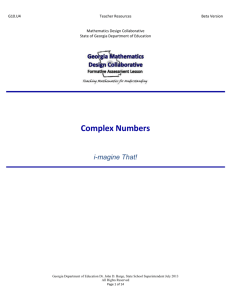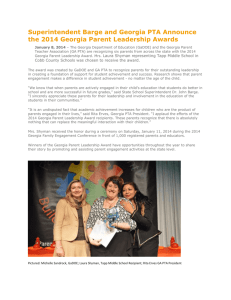
G9.U1
Teacher Resources
Beta Version
Mathematics Design Collaborative
State of Georgia Department of Education
Appropriate Scaling for Linear Graphs, Understanding
Constraints
The Largest Loser
Georgia Department of Education Dr. John D. Barge, State School Superintendent July 2013
All Rights Reserved
Page 1 of 17
G9.U1
Teacher Resources
Beta Version
INTRODUCTION TO THIS FORMATIVE ASSESSMENT LESSON
MATHEMATICAL GOALS
This lesson unit is intended to help you assess how well students are able to:
Utilize what they already know about linear equations in the context of different graphs.
Reasoning quantitatively, choose and interpret the appropriate scale and rate of change from graphs.
Understand Constraints upon graphs in given contexts and make sense of graph problems with differentlydefined axes of measure.
Reason abstractly and compare graphs of linear equations with different scales of measure.
GEORGIA STANDARDS OF EXCELLENCE
This lesson involves mathematical content in the standards from across the grades, with emphasis on::
MGSE9-12 N.Q.1 Use units of measure (linear, area, capacity, rates, and time) as a way to understand
problems:
a. Identify, use, and record appropriate units of measure within context, within data displays, and on
graphs;
b. Convert units and rates using dimensional analysis (English-to-English and Metric-to-Metric without
conversion factor provided and between English and Metric with conversion factor);
c. Use units within multi-step problems and formulas; interpret units of input and resulting units of
output.
MGSE9-12.N.Q.3 Choose a level of accuracy appropriate to limitations on measurement when reporting
quantities. For example, money situations are generally reported to the nearest cent (hundredth). Also, an
answers’ precision is limited to the precision of the data given.
MGSE9-12.A.CED.2 Create linear, quadratic, and exponential equations in two or more variables to represent
relationships between quantities; graph equations on coordinate axes with labels and scales. (The phrase “in
two or more variables” refers to formulas like the compound interest formula, in which A = P(1 + r/n)nt has
multiple variables.)
SMP1. Make sense of problems and persevere in solving them.
SMP2. Reason abstractly and quantitatively.
SMP4. Model with mathematics
SMP5. Use appropriate tools strategically.
SMP6. Attend to precision.
INTRODUCTION
This lesson is structured in the following way:
Before the Lesson,
Have students do the Pre-Assessment task in class or for homework, a day or more before the formative assessment
lesson. This will give you an opportunity to assess the work, and to find out the kinds of difficulties students have
with it. You will then be able to target your help more effectively in the follow-up lesson.
At the Start of the Lesson,
Have students work independently at the beginning of the lesson. They complete the chart that shows the sliding scale
for Barbie’s weight loss.
During the Lesson,
Group students in pairs by common errors found in Pre-Assessment. Students are given precut card sets A and B.
Students should match one card from A with one card from B.
After the Whole-Group Class Discussion,
Give students a second blank copy of their tasks back. Return to the students their original assessment task if you
choose.
Georgia Department of Education Dr. John D. Barge, State School Superintendent July 2013
All Rights Reserved
Page 2 of 17
G9.U1
Teacher Resources
Beta Version
MATERIALS REQUIRED
Each individual student will need:
Precut card sets of A and B
Poster Paper
Markers
Glue Sticks or Tape
TEACHER PREP REQUIRED
Teacher, be advised that prior to the lesson, the following preparations/copies will need to be made:
Copies of Materials
Precut card sets of A and B
TIME NEEDED:
For Pre-Assessment: 15 min
For Lesson: 55 min
For Post: 20 min
FRAMING FOR THE TEACHER:
This FAL should be done at the end of the unit. Failure to read and interpret graphs for what they actually say is a
common error students make. Note that the activity itself (slope, y-intercept, graphing lines, equations of lines) is
really the focus of this lesson, even though their existence adds meat to the lesson. This FAL allows students to use
some linear equation skills as a tool for investigating relationships between quantities rather than a free-standing skill.
FRAMING FOR THE KIDS:
Say to the students:
This activity will take about __2__days for us to complete.
The reason we are doing this is to be sure that you understand: how to read and interpret relationships between
quantities before we move on to a new idea.
You will have a chance to work with a partner to correct any misconceptions that you may have. After the partner
work, you will be able to show me what you have learned!
Georgia Department of Education Dr. John D. Barge, State School Superintendent July 2013
All Rights Reserved
Page 3 of 17
G9.U1
Teacher Resources
Beta Version
PRE-ASSESSMENT BEFORE THE LESSON
ASSESSMENT TASK: The Largest Loser
Time This Should Take: 15 minutes
Have the students do this task in class or for homework, a day or more before the formative assessment lesson. This
will give you an opportunity to assess the work, and to find out the kinds of difficulties students have with it. You
will them be able to target your help more effectively in the follow-up
lesson.
Give each student a copy of the Pre-Assessment: The Largest Loser
Briefly introduce the task and help the class to understand the problem
and its context.
Spend 15 minutes working individually on this task. Read through the
task and try to answer it as carefully as you can. Show all your work so
that I can understand your reasoning. Don’t worry if you can’t complete
everything. There will be a lesson that should help you understand these
concepts better. Your goal is to be able to confidently answer questions
similar to these by the end of the next lesson.
Students should do their best to answer these questions, without teacher
assistance. It is important that students are allowed to answer the questions on their own so that the results show what
students truly do not understand.
Students should not worry too much if they cannot understand nor do everything on the pre-assessment, because in
the next lesson they will engage in a task which is designed to help them. Explain to students that by the end of the
next lesson, they should expect to be able to answer questions such as these confidently.
This is their goal.
Georgia Department of Education Dr. John D. Barge, State School Superintendent July 2013
All Rights Reserved
Page 4 of 17
G9.U1
Teacher Resources
Beta Version
COLLABORATION TIME/READING STUDENTS RESPONSES
You Will Not “Grade” These!
Collect students’: responses to the task. It is helpful to read students’ responses with colleagues who are also
analyzing student work. Make notes (on your own paper, not on their pre-assessment) about what their work reveals
about their current levels of understanding, and their approaches to the task. You will find that the misconceptions
reveal themselves and often take similar paths from one student to another, and even from one teacher to another.
Some misconceptions seem to arise very organically in students’ thinking. Pair students in the same classes with
other students who have similar misconceptions. This will help you to address the issues in fewer steps, since they’ll
be together. (Note: pairs are better than larger groups for FAL’s because both must participate in order to discuss!)
You will begin to construct Socrates-style questions to try and elicit understanding from students. We suggest you
write a list of your own questions; however some guiding questions and prompts are also listed below as a jumpingoff point.
GUIDING QUESTIONS
COMMON ISSUES
SUGGESTED QUESTIONS AND PROMPTS
Student Was Unable to Begin Assessment
Example: “I don’t know who won,” “You can’t tell who
lost the most weight, because you can’t see what their
original weights were.”
Student did not note that the y-axes on the two graphs
represented different measures.
Example: “Mike Lost 6 pounds in 10 weeks, and Ramon
Lost 5 pounds in 10 weeks”
Student read Mike’s “Pounds Lost” as equivalent to
Ramon’s “Pounds Left to Lose.”
Example: “Mike’s weight went up, but Ramon’s weight
went down, and so Ramon lost more weight.”
Student did not identify the two contestants’ weight loss
as equal over the given number of weeks.
Example: Student does not realize that Mike losing 6
pounds over 10 weeks is the same as Ramon’s goal
moving from 10 pounds to four pounds in the same
amount of time means that he also lost 6 pounds.
Student unable to calculate correct rate of weight loss.
Example: Student mentioned weight loss/decreasing
distance to weight loss goal but did not mention specific
quantities
If you pointed to a location on Mike’s graph, what
would it mean in terms of the graph labels?
If you just pretended both Mike & Ramon both
weighed 300 pounds at start, could you make chart
that showed how much they weighed at start, at 2
weeks, at 4 wks, at 6 wks, at 8 wks, & at 10 wks?
What differences do you see in labels on two graphs?
Look at Mike’s graph. How long did it take him to lose
two pounds? What y-value shows you that?
Ramon wanted to lose 10 pounds, right? So what yvalue shows when he already lost 2 pounds? How
long did that take Ramon?
Does it mean the same thing for your weight to
decrease and for your goal to decrease?
If I spent $25 less this week than last week, can you
think of another way to say that?
If I already ran 20 yards of 100-yard dash, how many
yards do I have left to run toward my 100-yard goal?
If I moved 10 lbs away from my weight loss goal, what
does that mean I did?
Ramon’s goal was to lose 10 lbs, and right here (point
to 4 wks) it shows he has 8 lbs left. Did he get 2 lbs
closer to his goal or 2 lbs farther away from his goal?
If Ramon is 2 lbs closer to goal, how much was lost?
Can you think of a mathematical term that means “rate
of change?”
How do you calculate slope of a line?
Georgia Department of Education Dr. John D. Barge, State School Superintendent July 2013
All Rights Reserved
Page 5 of 17
G9.U1
Teacher Resources
Student was unable to explain his or her reasoning for
deciding a winner in the Largest Loser contest
Example: Student says “just because” or fails to make a
case that is backed up by numerical calculations.
Student Was Unable to Begin Assessment
Example: “I don’t know who won,” “You can’t tell who
lost the most weight, because you can’t see what their
original weights were.”
Beta Version
How would you tell someone you are right about your
decision, if they insist that you are wrong?
How can you demonstrate numerically with data which
“loser” is the winner?
If you pointed to a location on Mike’s graph, what
would it mean in terms of the graph labels?
If you just pretended both Mike and Ramon both
weighed 300 lbs at start, could you make a chart that
showed how much they weighed at start, at 2 wks, at 4
wks, at 6 wks, at 8 wks, and at 10 wks?
Georgia Department of Education Dr. John D. Barge, State School Superintendent July 2013
All Rights Reserved
Page 6 of 17
G9.U1
Teacher Resources
Beta Version
LESSON DAY
SUGGESTED LESSON OUTLINE:
Part 1: Whole-Class Introduction:
Time to Allot: ( 10 minutes)
If you have a short lesson, or you find the lesson is progressing at a slower pace than anticipated, then we suggest you end the
lesson after the first collaborative activity and continue in a second lesson.
Whole-class interactive introduction:
Students complete the activity independently at the beginning of the lesson. They complete the chart that shows the sliding scale
for Barbie’s weight loss.
Suggested Prompts:
Questions to ask:
What does the y-intercept of the original graph represent? (i.e. what is Barbie’s goal?)
What is the relationship between the pounds left to lose and the weight lost? How can you figure out weight lost if you
know how many pounds Barbie has left to lose?
Will Barbie meet her goal? If so, when?
How did you figure out the values beyond the parts of the graph you can see (if Barbie continues on this same track)?
What equation can you write that would show Barbie’s weight loss?
Part 2: Collaborative Activity:
Time to Allot: ( 40 minutes)
Georgia Department of Education Dr. John D. Barge, State School Superintendent July 2013
All Rights Reserved
Page 7 of 17
G9.U1
Teacher Resources
Beta Version
Put students into their pairs according to your analysis of student errors.
Do/Say the Following:
Collaborative Activity Part 1: (_20_ Minutes)
Group students in pairs by common errors found in Formative Assessment comparing Mike and Ramon’s weight loss.
Students are given card sets A and B, already cut apart.
Students should match one card from A with one card from B.
Collaborative Activity Part 2: Sharing or Presenting (20 minutes)
Students will put the contestants in order from most successful in losing weight to least
successful.
These contestants will be ranked by name and graph letter.
The students will demonstrate the rate of change for each graph in terms of weight loss, not in
terms of amount of weight left to lose.
During the Collaborative Activity, the Teacher has 3 tasks:
Circulate to students’ whose errors you noted from the pre-assessment and support their reasoning with your
guiding questions.
Circulate to other students also to support their reason in the same way.
Make a note of student approaches for the summary (plenary discussion). Some students have interesting and
novel solutions!
Part 3: Plenary (Summary) Discussion:
Time to Allot: ( 20 minutes)
Gather students together, share solutions. Discussion prompts should be made up of your original guiding questions and
notes about student approaches. Some other discussion prompts are listed below:
NOTE: “Scribing” helps to increase student buy-in and participation. When a student answers your question, write the
student’s name on the board and scribe his/her response quickly. You will find that students volunteer more often when
they know you will scribe their responses – this practice will keep the discussions lively and active!
Students will present their charts.
So who was the winner?
How can you be sure that your equation is correct for any of these situations?
What do you notice about the rate of change for those contestants who were at the top?
What do you notice about the rates of change for those contestants who were at the bottom?
What did the horizontal line represent?
What would a negative y value represent?
If the y-intercept was negative 30, what would that mean?
What would you infer if the y-intercept were 80?
What you tell George if his weight loss equation were y = 2x + 45?
Part 4: Improving Solutions to the Assessment Task
Time to Allot: ( 20 minutes)
The Shell MAP Centre advises handing students their original assessment tasks back to guide their responses to their
new Post-Assessment (which is sometimes the exact same as the Pre-Assessment). In practice, some teachers find that
students mindlessly transfer incorrect answers from their Pre- to their Post-Assessment, assuming that no “X” mark
means that it must have been right. . Until students become accustomed to UNGRADED FORMATIVE assessments,
they may naturally do this. Teachers often report success by handing students a list of the guiding questions to keep in
mind while they improve their solutions.
Georgia Department of Education Dr. John D. Barge, State School Superintendent July 2013
All Rights Reserved
Page 8 of 17
G9.U1
Teacher Resources
Beta Version
Practice will make perfect, and teachers should do what makes them most comfortable with their students/finds
misconceptions!
Georgia Department of Education Dr. John D. Barge, State School Superintendent July 2013
All Rights Reserved
Page 9 of 17
G9.U1
Teacher Resources – Answer Documents
Beta Version
PRE-ASSESSMENT (Answer Key)
ASSESSMENT TASK: The Largest Loser Graphs
The Largest Loser Graphs
Mike and Ramon are both contestants in a weight loss contest. Part of the contest requires that they graph their
progress. See their charts, below.
1.
You are one of the contest judges. Look carefully at the two graphs, and make a very detailed mathematical
case, in writing, below for which contestant you think should be named the winner that you think would be
convincing to the other judges. Looking at the graphs, it appears at first glance that Ramon lost more weight because
his graph is going downhill. But if you look at the y axis labels, they are different. So just looking at the graphs isn’t
enough to decide.
Looking at a chart may be a good way to approach this; also it may be good to make up a common starting weight for
both. If Mike and Ramon both started off at 300 pounds….
2. One of your fellow judges wants to know how fast each contestant lost weight. How could you explain how
he can calculate each contestant’s rate of weight loss?
The chart above shows that Mike and Ramon actually lost the same amount of weight. They both win! High Fives and
Ice Cream Sundaes all around!!!
Georgia Department of Education Dr. John D. Barge, State School Superintendent July 2013
All Rights Reserved
Page 10 of 17
G9.U1
Teacher Resources – Answer Documents
Collaborative Activity (Answer Key)
Georgia Department of Education Dr. John D. Barge, State School Superintendent July 2013
All Rights Reserved
Page 11 of 17
Beta Version
G9.U1
Student Resources
Beta Version
PRE-ASSESSMENT
The Largest Loser Graphs
Mike and Ramon are both contestants in a weight loss contest. Part of the contest requires that they graph their
progress. See their charts, below.
1. You are one of the contest judges. Look carefully at the two graphs, and make a case for which
contestant you think should be named the winner that you think would be convincing to the other judges.
2. One of your fellow judges wants to know how fast each contestant lost weight. How could you explain
how he can calculate each contestant’s rate of weight loss?
Georgia Department of Education Dr. John D. Barge, State School Superintendent July 2013
All Rights Reserved
Page 12 of 17
G9.U1
Student Resources
COLLABORATIVE ACTIVITY
Card Set A: Contestants
Contestant A
Contestant C
Contestant B
Contestant D
Georgia Department of Education Dr. John D. Barge, State School Superintendent July 2013
All Rights Reserved
Page 13 of 17
Beta Version
G9.U1
Student Resources
Contestant E
Contestant F
Contestant G
Contestant H
Georgia Department of Education Dr. John D. Barge, State School Superintendent July 2013
All Rights Reserved
Page 14 of 17
Beta Version
G9.U1
Student Resources
Beta Version
Card Set B: Situations
2
7
Mabel lost ½ pound each week. Gladys lost 1 pound each week.
6
3
Willomena gained 5 pounds
Emmy gained ½ pound each
each week.
week.
1
4
Hedwig gained 2 pounds each
Tricia lost 2 pounds each week.
week.
8
5
Ethel lost 3 pounds each week.
Hazel didn’t lose any weight.
Georgia Department of Education Dr. John D. Barge, State School Superintendent July 2013
All Rights Reserved
Page 15 of 17
G9.U1
Projector Resources
Beta Version
Lesson Day Warm-Up
Name of Assessment Task:
If the graph below shows Barbie’s progress toward her weight loss
goal, complete the TABLE below to show her progress. Then
complete the chart on the right.
Week
Pounds Left to
Number Lose
Weight Lost
Week
Number
1
6
2
7
3
8
4
9
5
10
Pounds Left to Weight Lost
Lose
Georgia Department of Education Dr. John D. Barge, State School Superintendent July 2013
All Rights Reserved
Page 16 of 17
G9.U1
Projector Resources
Beta Version
Collaborative Activity Instructions:
Collaborative Activity Instructions: The Largest Loser Contestants
were asked to make a chart of their progress over the last ten weeks.
Since they were given no more instructions than this, they made
different types of graphs.
1) You have been grouped in pairs.
2) You are given card sets A (each contestants’ graphs) and
B (each contestants’ results written out verbally), already
cut apart.
3) Read the graphs and situations very critically and very
carefully. You and your partner should match each graph
from card set A from each situation from card set B.
Discuss to ensure that you both agree.
4) Once you are sure that you have completed the matching
correctly, rank all of these contestants from “WINNER”
(most weight lost) all the way down to 8th place (least
weight lost).
5) Grab a sheet of chart paper and glue them, in order, paired.
6) Beside each pair, calculate (and write): RATE OF
WEIGHT LOST EACH WEEK.
7) If you finish early, beside each pair write the appropriate
LINEAR EQUATION. Be prepared to justify your
answers and to discuss.
Georgia Department of Education Dr. John D. Barge, State School Superintendent July 2013
All Rights Reserved
Page 17 of 17








